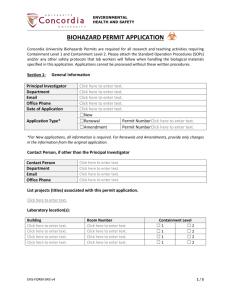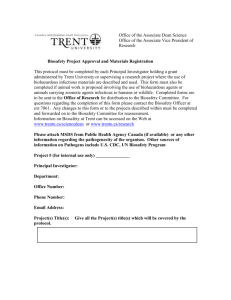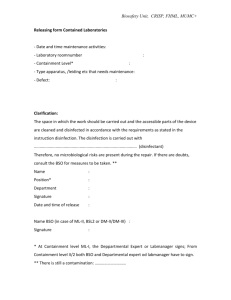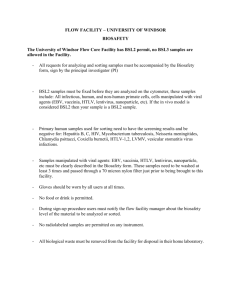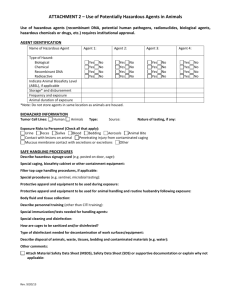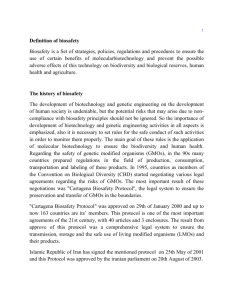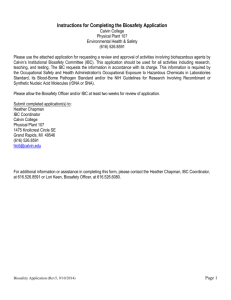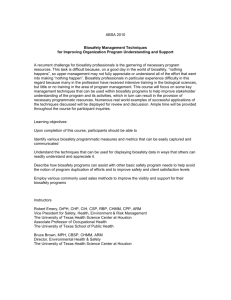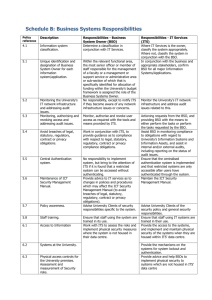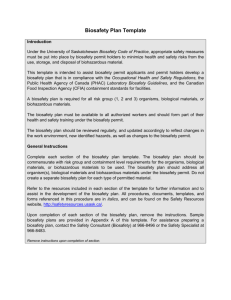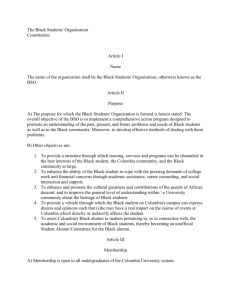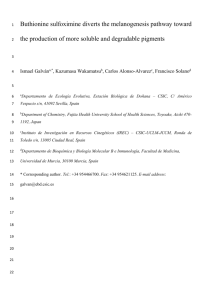Obtaining a Biosafety Work Permit
advertisement
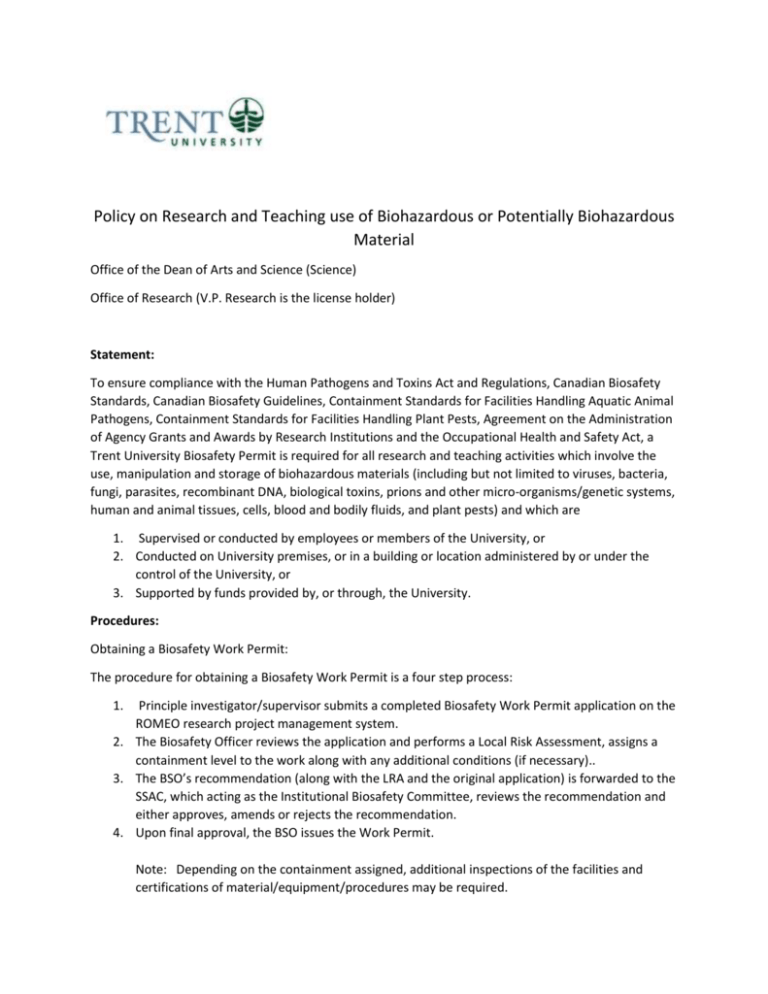
Policy on Research and Teaching use of Biohazardous or Potentially Biohazardous Material Office of the Dean of Arts and Science (Science) Office of Research (V.P. Research is the license holder) Statement: To ensure compliance with the Human Pathogens and Toxins Act and Regulations, Canadian Biosafety Standards, Canadian Biosafety Guidelines, Containment Standards for Facilities Handling Aquatic Animal Pathogens, Containment Standards for Facilities Handling Plant Pests, Agreement on the Administration of Agency Grants and Awards by Research Institutions and the Occupational Health and Safety Act, a Trent University Biosafety Permit is required for all research and teaching activities which involve the use, manipulation and storage of biohazardous materials (including but not limited to viruses, bacteria, fungi, parasites, recombinant DNA, biological toxins, prions and other micro-organisms/genetic systems, human and animal tissues, cells, blood and bodily fluids, and plant pests) and which are 1. Supervised or conducted by employees or members of the University, or 2. Conducted on University premises, or in a building or location administered by or under the control of the University, or 3. Supported by funds provided by, or through, the University. Procedures: Obtaining a Biosafety Work Permit: The procedure for obtaining a Biosafety Work Permit is a four step process: 1. Principle investigator/supervisor submits a completed Biosafety Work Permit application on the ROMEO research project management system. 2. The Biosafety Officer reviews the application and performs a Local Risk Assessment, assigns a containment level to the work along with any additional conditions (if necessary).. 3. The BSO’s recommendation (along with the LRA and the original application) is forwarded to the SSAC, which acting as the Institutional Biosafety Committee, reviews the recommendation and either approves, amends or rejects the recommendation. 4. Upon final approval, the BSO issues the Work Permit. Note: Depending on the containment assigned, additional inspections of the facilities and certifications of material/equipment/procedures may be required. Each Permit is issued for one year with up to 2 annual renewals (for a total of three years). Following the third year, a new Permit application must be resubmitted and a work permit issued. It is the responsibility of the Principal Investigator to inform the BSO when a project on a work permit is complete. Amendments to an active permit without a completed resubmission are allowed provided the amendments only include either: 1. Changes to Personnel, or 2. The addition of a biohazardous agent or method which does not increase the containment risk beyond that which was initially determined in the Local Risk Assessment. Amendments to an active permit can be submitted through the Romeo research data management system. Amendments should contain information on the new material/methods and a justification as to why there is no increase in the containment level required. Biosafety Progam: All personnel who work with biohazardous material must follow the Trent University Biosafety Program and any other applicable regulation/guidelines for the work they are doing. The Biosafety Program requires that all personnel working with Biohazardous material or in labs which contain biohazardous material complete the Science Safety Core Principles Training module and the appropriate Biosafety level 1, 2 or 3 as prescribed by the containment level assigned to the Permit. Refresher training is required every three years. PI/Supervisor Responsibilities: PI/Supervisors shall keep and post in the lab where the work is performed a list of personnel authorized to access and work with the biohazardous agents listed on the permits. PIs/Supervisors are responsible for informing the BSO when a specific work permit should be closed. PIs/Supervisors are responsible for obtaining a signature of the BSO on a Purchase Order prior to ordering any biohazardous material. The BSO and Supervisor are responsible for acquiring the correct import/work permits required by any other provincial or federal agency prior to purchasing and receiving new biohazardous material. Purchasing will not authorize the purchase of biohazardous material without the signature of the BSO. Purchase cards (Visa) are not to be used for the purchase of Biohazardous material. BSO Responsibilities: The BSO will manage the day to day operation of the Biosafety Program including managing the process of issuing work permits, conducting and documenting inspections and will be the point of contact for the university with the various regulatory agencies. The BSO may, if they deem the work immediately dangerous, issue a stop work directive for a project with a biosafety work permit. The BSO will document the situation and report to the VP Research and Dean which will review the situation and issue corrective actions. Continuing non-compliance with this policy, regulations and the biosafety program may result in the suspension of research funding and/or progressive disciplinary action according to university policies and procedures. Biosafety Program resources, guidelines and materials are accessible through the Science Safety Program. Glossary: BSO: Biosafety officer CFIA: Canadian Food Inspection Agency HAA: Health of Animals Act HAR: Health of Animals Regulations HPTA: Human Pathogens Toxins Act HPTR: Human Pathogens Toxins Regulations PHAC: Public Health Agency of Canada PI: Principal Investigator. The Principal Investigator/Supervisor are people directly affiliated with the University who are responsible for control or direct research programs and or projects. Students cannot be Supervisors for the purposes of this policy. TDG: Transportation Dangerous Goods Last revised Jan 8, 2016.

